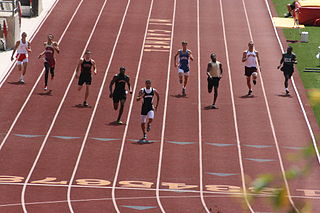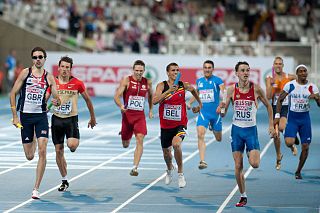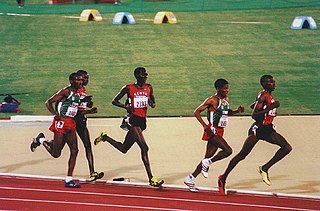This article only references primary sources.(October 2024) |
The following tables show the world record progression in the men's and women's 2000 metres as ratified by World Athletics.
This article only references primary sources.(October 2024) |
The following tables show the world record progression in the men's and women's 2000 metres as ratified by World Athletics.
World Athletics lists twenty-three progressive world records in the 2000 metres for men. The current world record is held by Jakob Ingebrigtsen of Norway, with his time of 4:43.13 set in September 2023. [1]
World Athletics lists six progressive world records in the 2000 metres for women. The current world record is held by Jessica Hull of Australia, with her time of 5:19.70 set in July 2024. [3]
| Time | Athlete | Nationality | Location | Date | Ref |
|---|---|---|---|---|---|
| 5:28.72 | Tatyana Kazankina | Moskva | 4 August 1984 | ||
| 5:28.69 | Maricica Puică | London | 11 July 1986 | ||
| 5:25.36 | Sonia O'Sullivan | Edinburgh | 8 July 1994 | ||
| 5:23.75 | Genzebe Dibaba | Sabadell | 7 February 2017 | ||
| 5:21.56 | Francine Niyonsaba | Zagreb | 14 September 2021 | ||
| 5:19.70 | Jessica Hull | Monaco | 12 July 2024 | [4] |
Middle-distance running events are track races longer than sprints, ranging from 500 metres up to two miles. The standard middle distances are the 800 metres, 1500 metres and mile run, although the 3000 metres may also be classified as a middle-distance event. The 1500 m came about as a result of running 3+3⁄4 laps of a 400 m outdoor track or 7+1⁄2 laps of a 200 m indoor track, which were commonplace in continental Europe in the 20th century.

The 400 metres, or 400-meter dash, is a sprint event in track and field competitions. It has been featured in the athletics programme at the Summer Olympics since 1896 for men and since 1964 for women. On a standard outdoor running track, it is one lap around the track. Runners start in staggered positions and race in separate lanes for the entire course. In many countries, athletes previously competed in the 440-yard dash (402.336 m)—which is a quarter of a mile and was referred to as the "quarter-mile"—instead of the 400 m (437.445 yards), though this distance is now obsolete.
The Memorial Van Damme is an annual athletics event at the King Baudouin Stadium in Brussels, Belgium, that takes place in late August or early September. Previously one of the IAAF Golden League events, it now serves as a final event of the Diamond League, along with Weltklasse Zürich between 2010 and 2019. In 2024 and 2026, Memorial Van Damme will serve as the sole final of the Diamond League.

The 100 metres, or 100-meter dash, is a sprint race in track and field competitions. The shortest common outdoor running distance, the 100-meter (109.36 yd) dash is one of the most popular and prestigious events in the sport of athletics. It has been contested at the Summer Olympics since 1896 for men and since 1928 for women. The inaugural World Championships were in 1983.

The 200 metres, or 200-meter dash, is a sprint running event. On an outdoor 400 metre racetrack, the race begins on the curve and ends on the home straight, so a combination of techniques is needed to successfully run the race. A slightly shorter race, called the stadion and run on a straight track, was the first recorded event at the ancient Olympic Games. The 200 m places more emphasis on speed endurance than shorter sprint distances as athletes predominantly rely on anaerobic energy system during the 200 m sprint. Similarly to other sprint distances, the 200 m begins from the starting blocks. When the sprinters adopt the 'set' position in the blocks they are able to adopt a more efficient starting posture and isometrically preload their muscles. This enables them to stride forwards more powerfully when the race begins and start faster.

The 4 × 400 metres relay or long relay is an athletics track event in which teams consist of four runners who each complete 400 metres or one lap, totaling 1600 meters. It is traditionally the final event of a track meet. The first leg and the first bend of the second leg are run in lanes. Start lines are thus staggered over a greater distance than in an individual 400 metres race; the runners then typically move to the inside of the track. The slightly longer 4 × 440 yards relay, on an Imperial distance, was a formerly run British Commonwealth and American event, until metrication was completed in the 1970s.

60 metres, or 60-meter dash, is a sprint event in track and field. It is a championship event for indoor championships, normally dominated by the best outdoor 100 metres runners. At indoor events, the 60 metres is run on lanes set out in the middle of the 'field', as is the hurdles event over the same distance, thus avoiding some of the effects of the banked track encircling the venue, upon which other track events in indoor events are run. At outdoor venues it is a rare distance, at least for senior athletes. The format of the event is similar to other sprint distances. The sprinters follow three initial instructions: 'on your marks', instructing them to take up position in the starting blocks; 'set', instructing them to adopt a more efficient starting posture, which also isometrically preloads their muscles. This will enable them to start faster. The final instruction is the firing of the starter's pistol. Upon hearing this the sprinters stride forwards from the blocks.

The 1500 metres or 1,500-metre run is the foremost middle distance track event in athletics. The distance has been contested at the Summer Olympics since 1896 and the World Championships in Athletics since 1983. It is equivalent to 1.5 kilometers or approximately 15⁄16 miles. The event is closely associated with its slightly longer cousin, the mile race, from which it derives its nickname "the metric mile".

The 10,000 metres or the 10,000-metre run is a common long-distance track running event. The event is part of the athletics programme at the Olympic Games and the World Athletics Championships, and is common at championship-level events. The race consists of 25 laps around an Olympic-sized 400 m track. It is less commonly held at track and field meetings due to its duration. The 10,000-metre track race is usually distinguished from its road running counterpart, the 10K run, by referring to the distance in metres rather than kilometres.

The 100 metres hurdles, or 100-meter hurdles, is a track and field event run mainly by women. For the race, ten hurdles of a height of 33 inches (83.8 cm) are placed along a straight course of 100 metres (109.36 yd). The first hurdle is placed after a run-up of 13 metres from the starting line. The next 9 hurdles are set at a distance of 8.5 metres from each other, and the home stretch from the last hurdle to the finish line is 10.5 metres long. The hurdles are set up so that they will fall over if bumped into by the runner, but weighted so this is disadvantageous. Fallen hurdles do not count against runners provided that they do not run into them on purpose. Like the 100 metres sprint, the 100 m hurdles begins with athletes in starting blocks.

The 5000 metres or 5000-metre run is a common long-distance running event in track and field, approximately equivalent to 3 miles 188 yards or 16,404 feet 2 inches. It is one of the track events in the Olympic Games and the World Championships in Athletics, run over 12+1⁄2 laps of a standard 400 m track, or 25 laps on an indoor 200 m track. The same distance in road running is called a 5K run; referring to the distance in metres rather than kilometres serves to disambiguate the two events. The 5000 m has been present on the Olympic programme since 1912 for men and since 1996 for women. Prior to 1996, women had competed in an Olympic 3000 metres race since 1984. The 5000 m has been held at each of the World Championships in Athletics in men's competition and since 1995 in women's.

The 3000 metres or 3000-metre run is a track running event, also commonly known as the "3K" or "3K run", where 7.5 laps are run around an outdoor 400 m track, or 15 laps around a 200 m indoor track.

The Herculis is an annual track and field meet at Stade Louis II in Fontvieille, Monaco. Previously one of the five IAAF Super Grand Prix events, it is now part of the Diamond League.
The 2000 metres or 2000-metre run is a track running event where five laps are completed around an outdoor 400 m track, or ten laps around a 200 m indoor track - the distance is 11.68 meters short of 1¼ miles.
The 2000 meter steeplechase is a rarely run senior athletics and a standard youth athletics event for the steeplechase in track and field. The event was part of the athletics programme for boys and girls at the IAAF World Youth Championships in Athletics. It is an obstacle race over the distance of 2000 metres, and derives its name from the horse racing steeplechase.
The mixed 4 × 400 metres relay is a mixed-sex 4 × 400 metres relay in which teams field two men and two women. Since March 2022, team members have to run in the order man-woman-man-woman. It was introduced at the 2017 IAAF World Relays and was then held at the 2019 World Athletics Championships in Qatar.